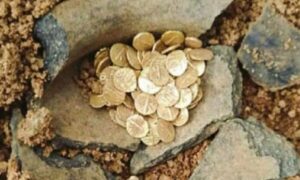Unearthed Secrets: Mysterious Tomb of an Ancient Egyptian ‘Wizard’ Doctor Reveals 4,000-Year-Old Medical Mysteries!
Imagine stumbling upon a 4,000-year-old tomb that belonged to a so-called ‘wizard’ doctor — one who healed Pharaohs and concocted potions that would make even today’s health gurus jealous! Well, that’s exactly what archaeologists unraveled in the hauntingly beautiful City of the Dead, nestled near the ancient capital of Memphis in Egypt. This incredible discovery is turning heads and shaking up our understanding of ancient medical practices, especially since it also coincides with other game-changing finds dating back 3,600 years. Who knew digging around in dirt could rewrite history? Dive in and discover the remarkable story of Teti Neb Fu, the palace’s chief medical magician, who might have been the original snake-venom expert! It’s like a history lesson with a side of sorcery! Curious to find out more? LEARN MORE.
Archaeologists digging in to the remains of Ancient Egypt have come across the 4,000 year old remains of a ‘wizard’ doctor who was famous for healing Pharaohs.
The find comes as experts have come across a ‘history rethinking’ find from 3,600 years ago with hidden tombs and burial shafts found in area where Tutankhamun was found.
Found in the area of Egypt known as the City of the Dead, it is an area with ancient burial grounds and ancient buildings dating back to far before the birth of Jesus Christ.
The new tomb is said to belong to Teti Neb Fu, an Ancient Egyptian doctor who was seen as a ‘wizard’ and sorcerer to the leaders of the time.

The tomb of Teti Neb Fu (Egyptian Ministry of Tourism and Antiquities)
Among the names he was known by, Teti Nab Fu was called a ‘chief doctor of the palace’ as well as a ‘priest’ and a ‘magician’.
There was also ‘chief dentist’ as well as ‘director of medicinal plants’ – so his standing was clearly important.
According to the BBC, experts believe his speciality as a follower of the healing goddess Serket could have been in treating scorpion and snake bites, which would explain his important position.
The Egyptian Ministry of Tourism and Antiquities has announced the discovery this week in the old town of Saqqara; a location south of Cairo with ancient burial grounds of Egyptian royalty.

It had been cleared of items of monetary value a long time ago (Egyptian Ministry of Tourism and Antiquities)
It also served as the necropolis for the ancient Egyptian capital of Memphis.
In a statement, the ministry said: “The tomb is adorned with stunning carvings and vibrant artwork, including a beautifully painted false door and scenes of funerary offerings.”
Sadly like many locations in Ancient Egypt, items of historical and monetary value were looted a long time ago.
But carvings and hieroglyphics from inside the burial chamber and on the coffin were able to allow French and Swiss archaeologists to confirm it belonged to Teti Neb Fu, who lived during the reign of King Pepe II of the sixth dynasty.
For context, this was a period of time dating back to between 2,305BC and 2,118BC.

The Stepped Pyramid of Djoser, Saqqara (Getty Stock Images)
This area of Saqqara has been the focus of excavation efforts since 2022, with them continuing across 2025, as experts expect to come across more hidden gems, clues and information gaps from thousands of years ago that tell us more about life back then.
It comes just days after the Zahi Hawass Foundation for Antiquities and Heritage, a foundation established by Egyptian archaeologist Zahi Hawass, came across a 3,600 year old hidden burial shafts and tombs with almost a dozen coffins.
Carved in to rock in the ancient city of Luxor, the discovery was made last Wednesday in an area of Queen Hatshepsut’s funeral temple at Deir al-Bahri on the Nile’s West Bank.
Artefacts found include wooden coffins, funeral masks, amulets, pottery tables, and archery bows.



















